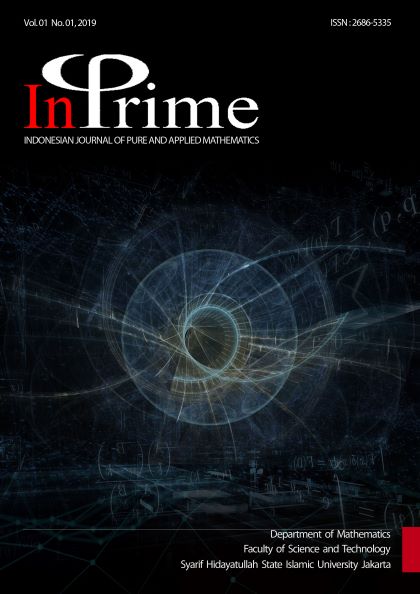Prediction of The Number of Ship Passengers in The Port of Makassar using ARIMAX Method in The Presence of Calender Variation
DOI:
https://doi.org/10.15408/inprime.v1i1.12786Abstract
AbstractIndonesia is an archipelago with the largest Muslim population in the world. Every year, Indonesian people have a tradition of meeting relatives in other areas or take a vacation on Eid al-Fitr. People use different modes of transport to travel such as air, water, and land transport. Port plays a role in supporting water transportation because it is a knot of inter-regional relations. The celebration of Eid al-Fitr moves forward by about 11 days every year. The purpose of this thesis is to make an estimate of the total departure of ship passengers in the main port of Makassar using the ARIMAX method with the effects of calendar variations. The ARIMAX method is a method that can be used when there are exogenous variables, where in this case the exogenous variable is in the form of variable dummy wich is Eid holidays. These forecasting results show that the ARIMAX method has a relatively small accuracy with the MAPE value of .
Keywords: water transportation; calendar variations effects; Eid Al-Fitr.
Abstrak
Indonesia merupakan negara kepulauan dengan mayoritas muslim terbesar didunia. Setiap tahun masyarakat Indonesia memiliki tradisi bertemu sanak saudara di daerah lain ataupun berlibur pada hari raya Idul Fitri. Jalur transportasi yang digunakan yaitu melalui darat, udara dan laut. Pelabuhan memiliki peran yang sangat penting dalam mendukung transportasi laut karena menjadi titik simpul hubungan antar daerah. Perayaan hari raya Idul Fitri dalam setiap tahun mengalami pergeseran 11 hari. Tujuan penulisan skripsi ini adalah untuk membuat prakiraan total keberangkatan penumpang kapal di Pelabuhan Utama Makassar menggunakan metode ARIMAX dengan efek variasi kalender. Metode ARIMAX merupakan metode yang dapat digunakan ketika data tersebut menggunakan variable eksogen, dimana dalam kasus ini variable eksogennya berupa variable dummy libur hari raya idul fitri. Hasil peramalan ini menunjukan bahwa metode ARIMAX memiliki tingkat akurasi yang lebih baik dibandingkan ARIMA musiman dengan nilai MAPE sebesar 14,08%.
Kata Kunci: transportasi air; efek variasi kalender, Hari Raya Idul Fitri.
References
BPS, "Proyeksi Penduduk Indonesia 2010-2035," The Central Berau of Statistics, Jakarta, 1913.
L.-M. Liu, "Analysis of Time Series with Calendar Effects," Management Science, vol. 26, pp. 106-112, 1980.
W. Cleveland and S. Devlin, "Calendar Effects in Monthly Time Series: Modeling and Adjustment," Journal of The American Statistical Association, vol. 77, pp. 520-528, 1982.
S. Hillmer, "Forecasting Time Series with Trading Day Variation," Journal of Forecasting, vol. 1, pp. 385-395, 1982.
S. Nasiru, A. Luguterah and L. Anzagra, "The Efficacy of ARIMAX and SARIMA Models in Predicting Monthly Currency in Circulation in Ghana," Mathematical Theory and Modeling, vol. 3, pp. 73-81, 2013.
A. Widarjono, Ekonometrika Pengantar dan Aplikasinya disertai Panduan EViews, Yogyakarta: UPP STIM YKPN, 2013.
J. D. Cryer and K.-S. Chan, Time Series Analysis with Applications in R Second Edition, New York: Springer-Verlag, 2008.
W. W. Wei, Time Series Analysis: Univariate and Multivariate Methods. Second Edition, United States of America: Greg Tobin, 2006.
D. Rosadi, Analisis Ekonometrika & Runtun Waktu Terapan dengan R, Yogyakarta: KOMINFO, 2011.
R. S. Tsay, Analysis of Financial Tima Series Second Edition, New York: John Wiley and Sons, Inc, 2005.
M. H. Lee, S. and N. A. Hamzah, "Calendar Variation Model Based on ARIMAX for Forecasting Sales Data with Ramadhan Effect," in Proceedings on the Regional Conference on Statistical Sciences (RCSS' 10), Malaysia, 2010.
B. P. Statistik, "https://www.bps.go.id/," [Online]. Available: https://www.bps.go.id/dynamictable/2015/03/10/818/total-keberangkatan-penumpang-dari-pelayaran-dalam-negeri-di-5-pelabuhan-utama-2006-2018-orang-.html. [Accessed 24 Juli 2018].
L.-M. Liu, "Identification of Time Series Models In The Presence of Calendar Variation," International Journal of Forecasting, vol. 2, pp. 357-372, 1986.

